PANASONIC Toughbook CF-19 User Manual
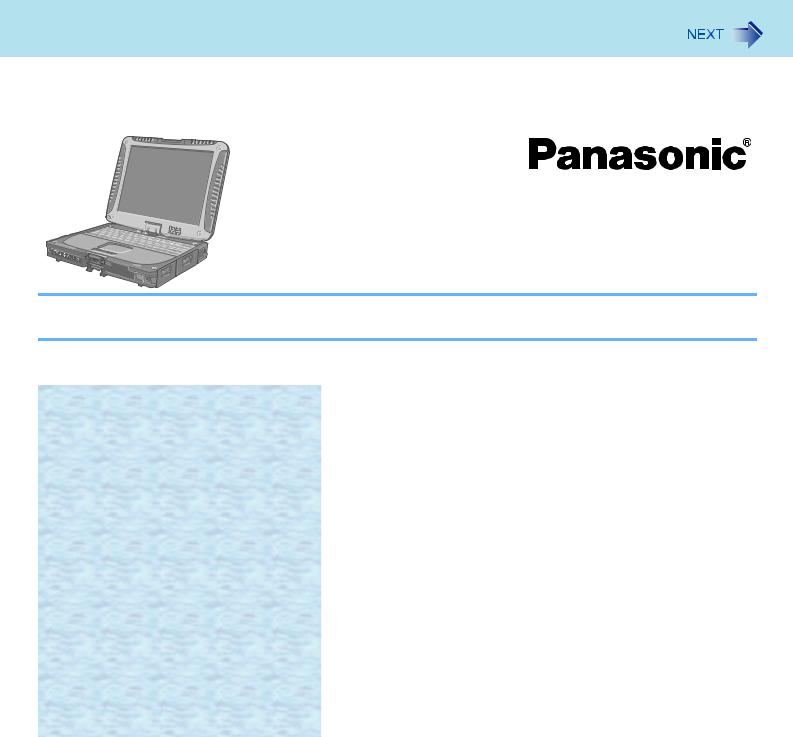
1
Reference Manual
Personal Computer
Model No. CF-19 Series
We recommend that this Reference Manual be printed.

Key Combinations |
2 |
|
|
NOTE
zDo not repeatedly press the keys in quick succession.
zDo not use the key combinations together with touch pad (external mouse), touchscreen (only for model with touchscreen), digitizer (only for model with digitizer), tablet buttons, or other key operations.
zDo not use the key combinations before you log on to Windows. Wait until the hard disk drive indicator  turns off. On the Setup Utility screen, you can use the key combinations of Fn+F1, Fn+F2 and Fn+F3.
turns off. On the Setup Utility screen, you can use the key combinations of Fn+F1, Fn+F2 and Fn+F3.
zThe key combinations may not work with some applications.
zThe popup menu icon appears after logging on to Windows. It may not appear in some application conditions (e.g., when [Command Prompt] is set to “Full Screen”).
|
Key |
|
|
|
|
|
|
Function |
Popup menu icon |
||||||||
|
|
|
|
|
|
|
|
|
|
|
|
|
|
|
|
|
|
|
|
+ |
|
|
|
|
LCD brightness |
|
|
|
|
|
|
|
|
||
|
Fn |
F1 |
|
|
|
|
|
|
|
|
|||||||
|
|
+ |
|
|
|
|
(Fn+F1= down / |
Fn |
+ |
F2 |
= up) |
|
|
|
|||
|
Fn |
F2 |
|
|
|
|
|
|
|
|
|
|
|
|
|
||
|
|
|
|
|
|
|
|
|
|
|
|
||||||
|
|
+ |
|
|
|
|
Display switching (Î page 40) |
|
|
|
|||||||
|
Fn |
F3 |
|
|
|
||||||||||||
|
|
|
|
|
|
|
(When an external display is connected) |
|
|
|
|||||||
|
|
|
|
|
|
|
Internal LCD |
|
|
Simultaneous display |
|
External display |
|
|
|||
|
|
|
|
|
|
|
|
|
|
|
|||||||
CAUTION
zDo not press any keys until the display has finished switching.
zDo not use this function:
•When an external display is not connected.
•When playing motion video such as DVD or MPEG.
•When using the Extended Desktop.
•When showing a game screen such as pinball.
zUntil Windows startup is completed (during Setup Utility, etc.), the simultaneous display cannot be used and pressing Fn+F3 switches the display between the internal LCD and the external display.
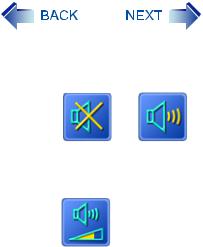
Key Combinations |
3 |
|
|
|
Key |
|
|
|
|
|
|
|
|
Function |
|
|
Popup menu icon |
|||||||||
|
|
|
|
|
|
|
|
|
|
|
|
|
|
|
|
|||||||
|
|
+ |
|
|
|
|
|
|
|
Speaker on/off |
|
|
|
|
|
|||||||
|
Fn |
F4 |
|
|
|
|
|
|||||||||||||||
|
|
|
|
|
|
|
|
|
|
|
|
|
|
|
|
|
|
|
|
|
|
|
|
|
|
|
|
|
|
|
|
|
|
NOTE |
|
|
|
|
|
|
|
|
|
|
|
|
|
|
|
|
|
|
|
|
|
|
z Beeps do not sound if you turn off the speaker sound. |
|
|
OFF |
ON |
|||||||
|
|
|
|
|
|
|
|
|
|
|
z You cannot turn off the sound of speakers connected to the USB port. |
|
|
|||||||||
|
|
|
|
|
|
|
|
|
|
|
|
|
|
|
|
|
|
|
|
(MUTE) |
|
|
|
|
|
|
|
|
|
|
|
|
|
|
|
|
|
|
|
|
|
||||
|
|
|
|
|
|
|
|
|
|
|
|
|
|
|
||||||||
|
|
+ |
|
|
|
|
|
|
|
Volume |
|
|
|
|
|
|||||||
|
Fn |
F5 |
|
|
|
|
|
|||||||||||||||
|
|
+ |
|
|
|
|
|
|
|
( |
Fn |
+F5= down / |
Fn |
+ |
F6 |
= up) |
|
|
|
|
|
|
|
Fn |
F6 |
|
|
|
|
|
|
|
|
|
|
|
|
|
|
|
|
||||
|
|
|
|
|
NOTE |
|
|
|
|
|
|
|
|
|
|
|||||||
|
|
|
|
|
|
|
|
|
|
|
|
|
|
|
|
|
||||||
|
|
|
|
|
|
|
|
|
|
|
z This does not work on beeps or speakers connected to the USB port. |
|
|
|
|
|
||||||
|
|
|
|
|
|
|
|
|
|
|
||||||||||||
|
|
|
|
|
|
|
|
|
|
|
|
|
||||||||||
|
|
+ |
|
|
|
|
Activate standby (Î page 15) |
|
|
|
|
|
||||||||||
|
Fn |
F7 |
|
|
|
|
|
|||||||||||||||
|
|
|
|
|
|
|
|
|
|
|
|
|||||||||||
|
|
|
|
|
|
|
|
|
|
|
|
|||||||||||
|
|
+ |
|
|
|
|
|
|
|
Remaining battery level |
|
|
(Î page 20) |
|
||||||||
|
Fn |
F9 |
|
|
|
|||||||||||||||||
|
|
|
|
|
|
|
|
|
|
|
||||||||||||
|
|
+ |
|
|
|
|
|
|
Activate hibernation (Î page 15) |
|
|
|
|
|
||||||||
|
Fn |
F10 |
|
|
|
|
|
|||||||||||||||
|
|
|
|
|
|
|||||||||||||||||
|
|
|
|
|
|
|
|
|
|
|
|
|
|
|
|
|
|
|
|
|
|
|

Key Combinations |
4 |
|
|
Hotkey Settings
You can make two settings:
•Fn key lock
Fn is locked (pressed-down) until you press another key. Use this when pressing difficult key combinations.
•Popup menu icon on/off
1 Start up the Hotkey Settings.
Click [start] - [All Programs] - [Panasonic] - [Hotkey Settings].
2 Make the settings.
[Use Fn key lock]
z When using an Fn key combination
APress Fn once. (Locked)
BPress another key. (Lock released)
z When using successive Fn key combinations
APress Fn twice. (Locked)
BPress another key.
Fn key remains locked until you press Fn again.
[Notification]
[Make sounds when Fn key is pressed]*1
[Show status on screen]: Displays the Fn key status on the notification area.
• : Fn is locked.
: Fn is locked.
• : Fn is not locked.
: Fn is not locked.
[Disable popup]
The popup menu icon will not be displayed.
3 Click [OK].
NOTE
z You can have different settings for each user.
*1 If the speakers are muted, beeps do not sound.
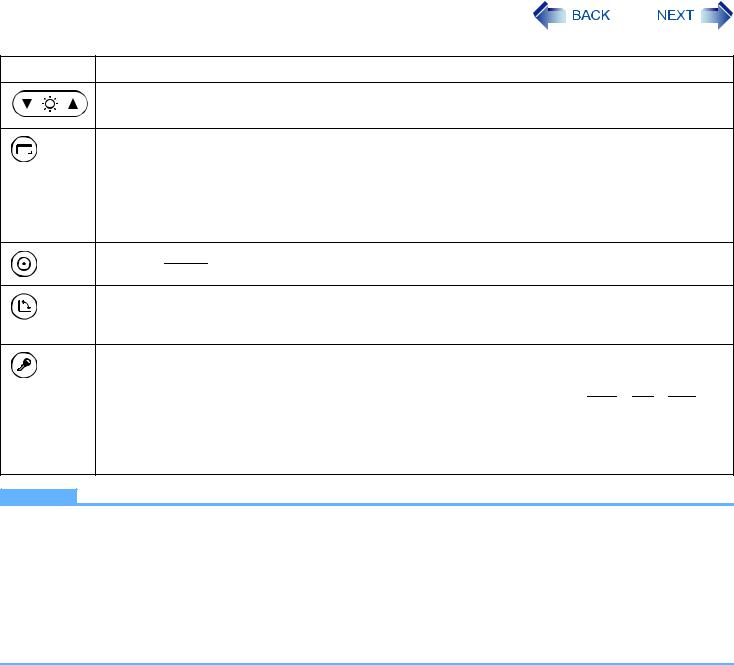
Tablet Buttons |
5 |
|
|
Button |
Function |
|
|
LCD Brightness
 : down /
: down /  : up
: up
Input Panel
<Only for model with Windows XP Professional> Software keyboard on/off (Î page 9)
<Only for model with Windows XP Tablet PC Edition> Tablet PC Input Panel on/off
z This button does not work on the Welcome screen.
Enter
Works as Enter.
Rotation
Rotates the display. (Î page 12)
z Do not press the button again until the display rotation is completed.
Security
<Only for model with Windows XP Professional> Locks the computer.
zOn the Windows logon screen and the Welcome screen, this button work as Ctrl + Alt + Del.
zThis button does not work on screensaver.
<Only for model with Windows XP Tablet PC Edition> Works as Ctrl + Alt + Del.
NOTE
zThe Tablet buttons work when the Windows screen is displayed.
zThe Tablet buttons may not work immediately after Windows is started up or the Windows logon screen (or the Welcome screen) is displayed.
<Only for model with Windows XP Professional>
zIf you set password input for resuming from screensaver, the Input Panel, Enter and Rotation buttons do not work on screensaver.
<Only for model with Windows XP Tablet PC Edition>
zWhen you press a tablet button, the message of “Your tablet computer can not perform this action. For assistance, contact your software manufacturer.” may appear. This is not a malfunction. Click [OK] and press the button again.

Tablet Buttons |
6 |
|
|
Setting the Tablet Buttons
NOTE
zYou can have different settings for each user.
zOn the Windows logon screen and Welcome screen, the tablet buttons are enabled and work in default irrespective of the settings you made.
To change the tablet button functions
You can change the functions of the Input Panel ( )/Enter (
)/Enter ( )/Rotation (
)/Rotation ( ) buttons.
) buttons.
1 Open the setting screen.
<Only for model with Windows XP Professional>
Click [start] - [All Programs] - [Panasonic] - [Tablet Buttons Settings].
<Only for model with Windows XP Tablet PC Edition>
Click [start] - [Control Panel] - [Printers and Other Hardware] - [Tablet and Pen Settings] - [Tablet Buttons].
2
3
Click the tablet button and click [Change].
Select the function in [Action].
zYou cannot select Fn for [Press a key or key combination].
zClick [Browse] to select the application if you select [Launch an application].
4
5
Click [OK].
Click [OK].
<Only for model with Windows XP Professional>
To disable the tablet buttons
You can disable the Security ( )/Input Panel (
)/Input Panel ( )/Enter (
)/Enter ( )/Rotation (
)/Rotation ( ) buttons.
) buttons.
1 Click [start] - [All Programs] - [Panasonic] - [Tablet Buttons Settings].
2 Remove the check mark from [Enable Security, Input Panel, Enter, Rotation Button.]
3 Click [OK].

Touchscreen |
7 |
|
|
<Only for model with touchscreen>
You can use the touchscreen function to perform the same operation as the touch pad and mouse. Touch the screen surface with the stylus (included).
z To right-click
AClick  on the notification area.
on the notification area.
 changes to
changes to  .
.
BClick the object you want to right-click.
 returns to
returns to  .
.
NOTE
zDo not touch the screen by hand or other object when you input using the stylus (included). Otherwise you may not be able to input correctly.
zYou need to make the following setting for each user.
AClick [start] - [All Programs] - [Fujitsu Touch Panel (USB)] - [Touch Panel Configuration].
BSelect the settings, and then click [OK].
z Do not add a check mark to [Delete Cursor] since the display may be distorted.
zIf you add a check mark for [Use] in [Hold [Ctrl] key down + Touch the screen] of [Touch Panel Configuration], touching the screen may always be recognized as a right-click. To return to the normal operation, press Ctrl on the keyboard.
zThe touchscreen function does not work in the Setup Utility, in the full screen of [Command Prompt], or in Recover Pro (Î page 69).
Touchscreen Calibration
1 Run [Touch Screen Calibration Utility].
Click [start] - [All programs] - [Fujitsu Touch Panel (USB)] - [Touch Screen Calibration Utility].
2 Using the stylus, touch each of the 12 “+” target marks one by one until it blinks, and then click [Calibration].
3 Click [Save & Exit].
NOTE
zReturn the rotated display to [0 degree] (Î page 12) before the touchscreen calibration.
zPerform the touchscreen calibration for each user.

Digitizer |
8 |
|
|
<Only for model with digitizer>
You can use the digitizer function to perform the same operation as the touch pad and mouse. Touch the screen surface with the pen (included).
For further information, click [start] - [All Programs] - [Get Going with Tablet PC]. z To right-click
A Press and hold the button (A) of the pen, and then tap the object.
NOTE
zThe digitizer function does not work in the Setup Utility, in the full screen of [Command Prompt], or in Recover Pro (Î page 69).
Digitizer Calibration
1 Run [Tablet and Pen Settings].
Double-click  or click [start] - [Control Panel] - [Printers and Other Hardware] - [Tablet and Pen Settings].
or click [start] - [Control Panel] - [Printers and Other Hardware] - [Tablet and Pen Settings].
2
3
Click [Settings] - [Calibrate].
Using the pen, touch each of the four “+” target marks one by one, and then click [OK].
z Perform the calibration for both [Landscape] and [Portrait].
NOTE
z Perform the digitizer calibration for each user.

Software Keyboard |
9 |
<Only for model with Windows XP Professional>
You can touch the screen keyboard using the stylus (included) to perform the same operation as the internal keyboard.
Starting the Software Keyboard
1 Press the Input Panel button  (A).
(A).
z Alternatively you can click [start] - [All Programs] - [Panasonic] - [Software Keyboard].
2 Touch the software keyboard using the stylus.
z To use shortcut key Example: Ctrl + C
Press Ctrl (turns blue) and then press C.
z To select the keyboard language, use the language bar (e.g.  ) on the notification area. If the keyboard language does not change, click the title bar of the software keyboard and then click on the application.
) on the notification area. If the keyboard language does not change, click the title bar of the software keyboard and then click on the application.
z Press the Input Panel button again to close the software keyboard. A. Software keyboard menu (Î page 10)
B. Moves the software keyboard to a corner of the screen. C. One tap : Works as shortcut key.
Two taps : Works as the  key.
key.
D. Works as a right-click. (Same function as the  key)
key)
NOTE
zTo use key combination (Ctrl + C etc.), use either of the internal keyboard or the software keyboard alone.
zYou cannot use Ctrl + Alt + Del on the software keyboard after logging on.
zYou cannot use the Fn key combination on the Windows logon screen and the Welcome screen.
zThe software keyboard may not work during shutdown of Windows.
zYou cannot use the software keyboard when the [Command Prompt] screen is set to “Full Screen”.
zYou can set a different language to each application ( Windows help), and the keyboard layout switches according to the application.
zDepending on the language, some keys are displayed in orange. You can use them to input characters such as ë and
ö.
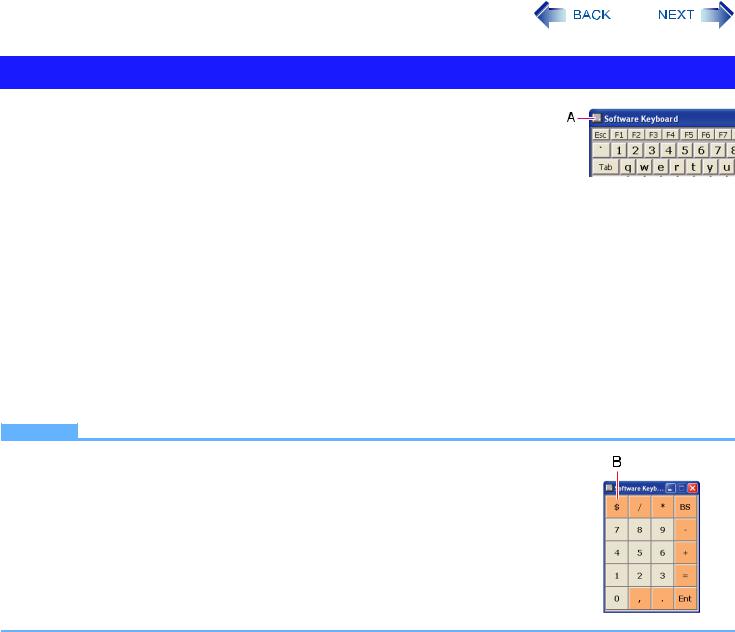
Software Keyboard |
10 |
|
|
Software Keyboard Menu
1
2
Click  (A).
(A).
Add a check mark to the function you want to use.
z[Auto Move]
The software keyboard moves automatically to avoid overlapping the selected window.
z[Auto Restore]
The software keyboard minimized on the notification area will be restored when you change the input mode. This may not work on some applications.
z[Always On Top]
The software keyboard always appears on the top.
z[Transparent]
The software keyboard appears semi-transparent.
z[Big Size]/[Medium Size]/[Small Size]
Select the size of the software keyboard.
z[Ten key (Big)]/[Ten key (Medium)]/[Ten key (Small)]
Select the size of the numeric keypad.
NOTE
zYou can change the currency symbol (B) of the numeric keypad.
Click [start] - [Control Panel] - [Date, Time, Language and Regional Options] - [Regional and Language Options] - [Regional Options] - [Customize] - [Currency] - [Currency symbol].

Panasonic Hand Writing |
11 |
|
|
<Only for model with Windows XP Professional>
You can make a bitmap file (.bmp) of a simple character and a figure such as signature by handwriting on the touch pad and the touchscreen.
CAUTION
zDo not use the Fast User Switching function while Panasonic Hand Writing is active.
zIf you install other pointing devices (e.g., commercially available mouse driver) and overwrite the touch pad driver, Panasonic Hand Writing will not work.
NOTE
zThe display of Panasonic Hand Writing may be distorted if the number of display colors is changed. Right-click  on the notification area and click [Exit Panasonic Hand Writing], and then restart Panasonic Hand Writing.
on the notification area and click [Exit Panasonic Hand Writing], and then restart Panasonic Hand Writing.
zPanasonic Hand Writing may not work properly if another application software is active. In this case, close the application software and try handwriting again.
Starting Panasonic Hand Writing
1 Double-click  on the notification area.
on the notification area.
Alternatively you can click [start] - [All Programs] - [Panasonic] - [Panasonic Hand Writing].
NOTE
zSelect the image size before handwriting by clicking [Option] - [Window size]. If you change the size after handwriting, the image quality will become lower.
zYou can copy the bitmap image by clicking [Edit] - [Copy], and paste it in another application software that supports bitmap format.
zThe touch pad mode will not work properly when using the extended desktop.
zThe touch pad mode will not work properly when the display is rotated 90 or 270 degree.
zThe touch pad mode will be canceled in the following cases.
•Switching to another application
•Resuming from standby or hibernation
•Pressing Alt
•Touching the touchscreen
zAn external mouse or trackball connected via the keyboard/mouse port of the port replicator (optional) or the car mounter (optional) will not work during handwriting in the touch pad mode.
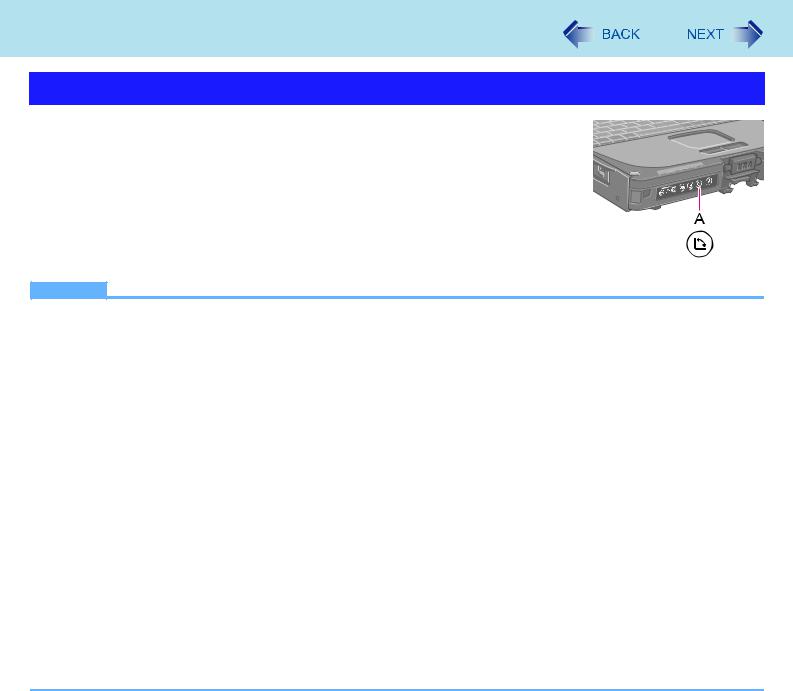
Display Rotation |
12 |
Rotating the Display
1 Press the Rotation button  (A).
(A).
Each time you press the button, the screen display rotates counter-clockwise by 90°.
NOTE
zAlternatively you can rotate the display by the following procedure. <Only for model with Windows XP Professional>
Double-click  on the notification area.
on the notification area.
<Only for model with Windows XP Tablet PC Edition>
Click [start] - [Control Panel] - [Printers and Other Hardware] - [Tablet and Pen Settings] - [Display].
zWhile the display is rotated:
•Do not use the Extended Desktop. The touch pad, touchscreen (only for model with touchscreen), or digitizer (only for model with digitizer) may not work properly.
•Do not calibrate the touchscreen (only for model with touchscreen).
•Do not set the resolution larger than that of the internal LCD.
•The computer’s performance is slightly lowered.
•The touch pad scroll, zoom, and data zoom functions do not work.
zYou cannot rotate the display when the [Command Prompt] is set to “Full Screen”.
<Only for model with Windows XP Professional>
zWhen the display is rotated, the motion video may not be displayed correctly or the sound may be distorted. Return the display angle to 0°.
zWhen you set the resolution to 800 x 600 pixels and rotate the display, the resolution shown in [Screen resolution] of [Display Properties] may not correspond to the correct resolution. This is not a problem.
<Only for model with Windows XP Tablet PC Edition>
zWhen the display is rotated, the motion video may not be displayed correctly or the sound may be distorted. Return the display angle to [Primary Landscape].
zWhen you set the resolution to 800 x 600 pixels, you can rotate the display to [Primary Landscape] and [Secondary Landscape] only.

Display Rotation |
13 |
|
|
Changing the Settings
1 Right-click  on the notification area and click [Setting].
on the notification area and click [Setting].
The Display Rotation Tool screen appears.
2
3
Change the settings.
Click [OK].
NOTE
z In the following cases, the display angle automatically returns to the default angle.
•When starting up Windows
•When switching the Laptop mode and Tablet mode
•When switching the logon user by the Fast User Switching function <Only for model with Windows XP Tablet PC Edition>
z You can set the order of display rotation positions in the following menu.
[start] - [Control Panel] - [Printers and Other Hardware] - [Tablet and Pen Settings] - [Display] - [Change]
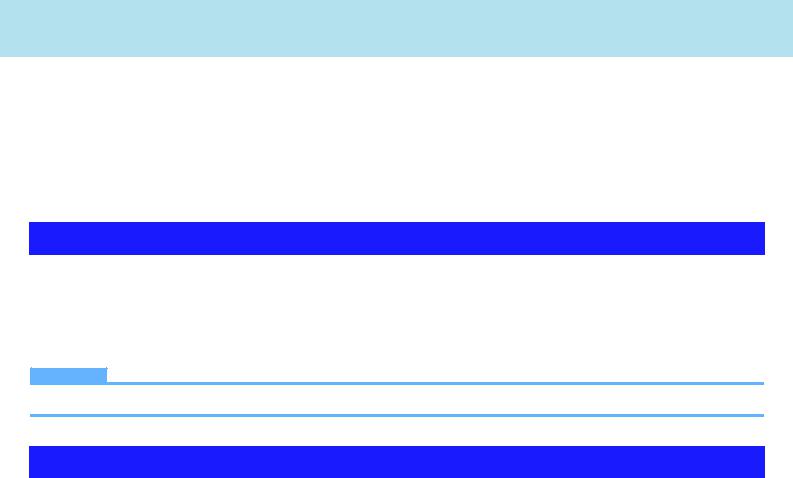
Standby and Hibernation Functions

 14
14 



The standby or hibernation function allows you to shut off the computer without closing programs and documents. You can quickly return to the programs and documents that you were working on before standby or hibernation.
Function |
Data is saved to |
Recovery time |
Power supply |
|
|
|
|
Standby |
Memory |
Short |
Required. (If power is not supplied, all data will be lost.) |
|
|
|
|
Hibernation |
Hard disk |
Rather long |
Not required. (However power is slightly consumed to |
|
|
|
keep the hibernation.) |
|
|
|
|
Setting Standby or Hibernation
1 Click [start] - [Control Panel] - [Performance and Maintenance] - [Power Options] - [Advanced].
2 Click [Stand by] or [Hibernate] for [When I close the lid of my portable computer:] / [When I press the power button on my computer:], and then click [OK].
NOTE
z You do not need to make the setting if you use the Windows menu to enter standby or hibernation.
Precautions
zConnect the AC adaptor if the computer will be in standby mode for a long period of time. If you cannot use the AC adaptor, use hibernation instead.
zUsing standby or hibernation repeatedly may cause malfunction of the computer. To stabilize computer operation, restart Windows regularly (about once a week) without using standby or hibernation.
zSave the necessary data.
zClose files you have opened from removable disk and network drive.
zThe password you set in the Setup Utility is not requested at resuming. You can use the Windows password for security in standby or hibernation.
AClick [start] - [Control Panel] - [User Accounts], and select the account.
BClick [Create a password] and set the password.
CClick [start] - [Control Panel] - [Performance and Maintenance] - [Power Options] - [Advanced], and add the check mark in [Prompt for password when computer resumes from standby].

Standby and Hibernation Functions |
15 |
|
|
zDo not enter standby or hibernation in the following conditions, otherwise the data or file may be corrupted, standby or hibernation may not work, or malfunction may occur in the computer or the peripheral devices.
•When the hard disk drive indicator  or the SD Memory Card indicator is on.
or the SD Memory Card indicator is on.
•When playing/recording audio files or displaying motion video such as MPEG files.
•When writing to a disk.
•When using communication software or network function.
•When using a PC Card.
(If the card fails to work normally, restart the computer.)
•When an external mouse is connected to the serial port.
zThe computer does not enter standby or hibernation immediately after resuming. Wait approximately one minute.
Entering/Resuming from Standby or Hibernation
To enter standby or hibernation
1 Close the display, or slide the power switch (A) until a beep*1 sounds.
Standby: The power indicator (B) blinks green. 

 Hibernation: The power indicator (B) goes off.
Hibernation: The power indicator (B) goes off. 



 z You can alternatively use the Windows menu to enter standby or hibernation. To
z You can alternatively use the Windows menu to enter standby or hibernation. To 



 enter standby, click [start] - [Turn Off Computer] - [Stand By]. To enter hiberna-
enter standby, click [start] - [Turn Off Computer] - [Stand By]. To enter hiberna- 




tion, click [start] - [Turn Off Computer], then press and hold Shift and click [Hibernate].
CAUTION
While the computer is entering standby or hibernation
zDo not:
•Touch the keyboard, touch pad, touchscreen (only for model with touchscreen), digitizer (only for model with digitizer), tablet buttons, or power switch.
•Use an external mouse or other peripheral device.
•Connect or disconnect the AC adaptor.
•Close or open the display.
Wait until the power indicator blinks green (standby) or goes off (hibernation).
zIt may take one or two minutes to enter standby or hibernation.
zAt the beep*1, immediately release the power switch. If you slide and hold the power switch for longer than four seconds, the computer will forcibly shut down and unsaved data will be lost even if you have set [Shut down] in [When I press the power button on my computer:] (Î page 14 “Setting Standby or Hibernation”).
*1 If the speakers are muted, beeps do not sound.
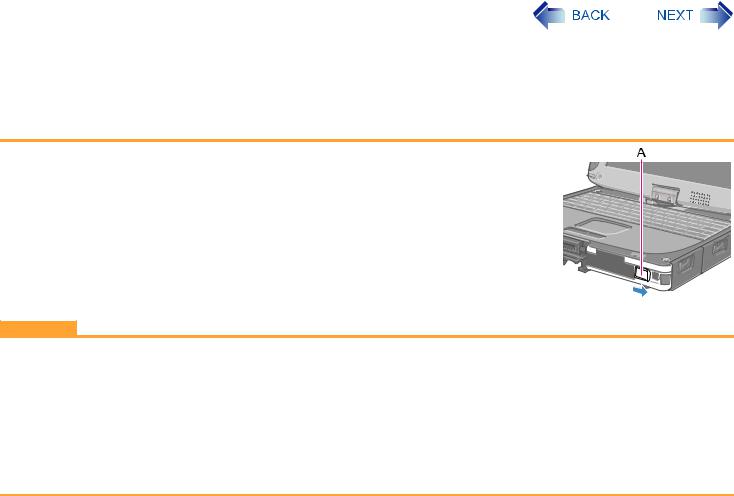
Standby and Hibernation Functions |
16 |
|
|
In standby or hibernation
zDo not attach or remove a peripheral device. Doing so may cause malfunction.
zPower is consumed in standby mode. Power consumption may increase when a PC Card is inserted. When power is exhausted, the data retained in memory will be lost. Connect the AC adaptor when using the standby function.
To resume from standby or hibernation
1 Open the display, or slide the power switch (A).
zWhen [Stand by] or [Hibernate] is selected as the setting for [When I close the lid of my portable computer] (Î page 14), you can resume operation opening the display. Note however opening the display does not work in the Tablet mode.
CAUTION
zDo not perform the following operations until resuming is complete. After the display has resumed, wait approximately 30 seconds (normally) or 60 seconds (when the computer is on a network).
•Touch the keyboard (except for password input), touch pad, touchscreen (only for model with touchscreen), digitizer (only for model with digitizer), tablet buttons, or power switch.
•Use an external mouse or other peripheral device.
•Connect or disconnect the AC adaptor.
•Close or open the display.
•Shut down or restart Windows.
•Enter standby or hibernation.
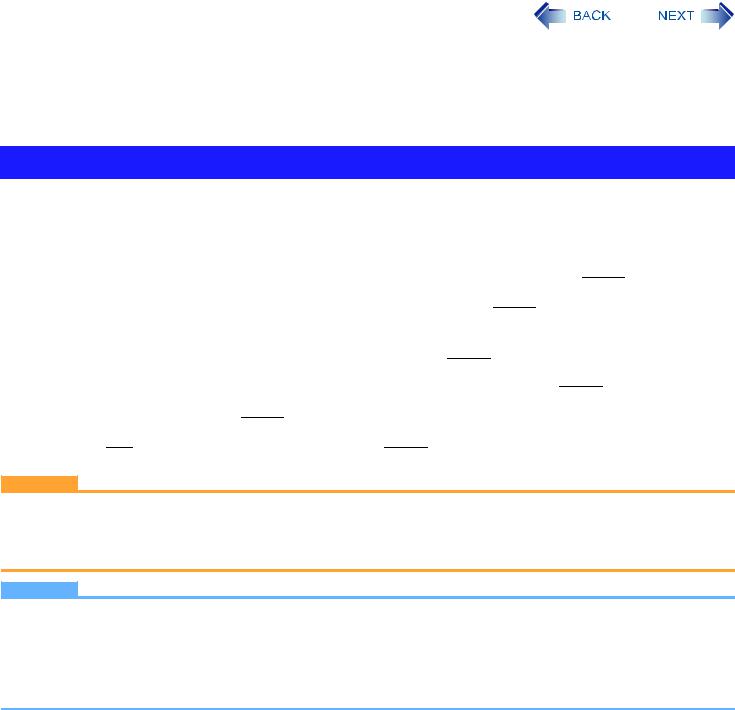
Security Measures |
17 |
|
|
Use these features to protect your data.
zOther security measures
•SD Security (Î page 31)
•Embedded Security (TPM) (Î page 62): For further information, refer to the Installation Manual of “Trusted Platform Module (TPM)”.
Setting the Supervisor Password/User Password
Set the Supervisor Password before setting the User Password.
1
2
3
4
Start up the Setup Utility (Î page 57).
Select [Security].
Select [Set Supervisor Password] or [Set User Password], and press Enter. Enter your password in [Enter New Password] and press Enter.
zWhen the password has been set, you need to enter your password in [Enter Current Password] and press
Enter.
zTo disable the password, leave the input field empty and press Enter.
5
6
7
Enter your password again in [Confirm New Password] and press Enter.
In [Setup Notice], press Enter.
Press F10, and then select [Yes] and press Enter.
CAUTION
zDo not forget your password. If you forget your Supervisor Password, you will not be able to use your computer. Contact Panasonic Technical Support.
zWhen running the Setup Utility, do not leave and go away from your computer even for a short time, since other people may set or change the password.
NOTE
zThe password will not be displayed on the screen.
zYou can use up to 32 alphanumeric characters (including spaces).
•The case (upper/lower) is ignored.
•To input numbers for the password, you cannot use the numbered keys on the keyboard.
•You cannot use Shift and Ctrl to input a password.
zDisabling the Supervisor Password also disables the User Password.
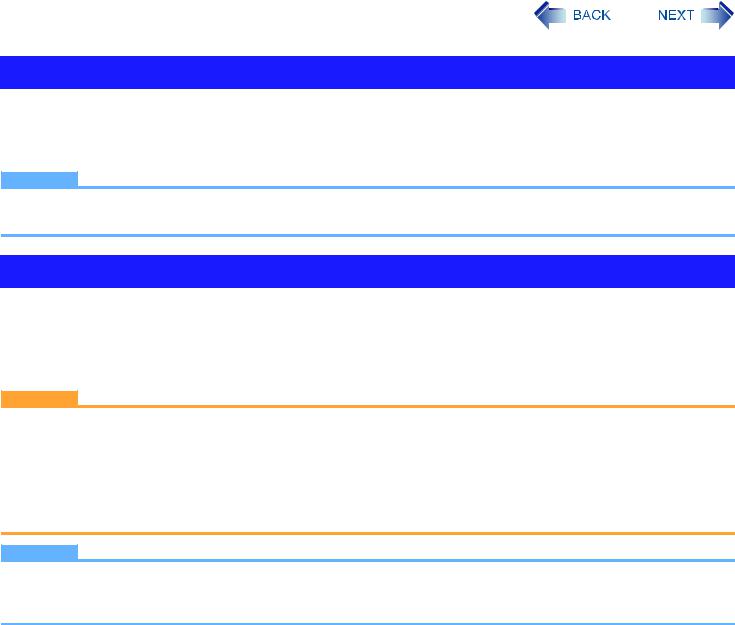
Security Measures |
18 |
|
|
Preventing Your Computer from Unauthorized Use
You can set a start-up password to protect your computer from unauthorized use.
1 Set the password (Î page 17), and select [Enable] in [Password on boot] in the [Security] menu of the Setup Utility (Î page 62).
NOTE
zIf the Supervisor Password or User Password has been set, the password input screen will be displayed on starting-up of the Setup Utility even though [Password on boot] is set to [Disable].
Preventing Your Hard Disk Data from Being Read or Written
The hard disk lock function protects the hard disk data from being read or written when the hard disk is attached to another computer. The data can be read/written when the hard disk is returned to the original computer. (Note that the hard disk lock does not guarantee complete protection of the data.)
1 Select [Enable] in [Hard Disk Lock] in the [Security] menu of the Setup Utility (Î page 62).
CAUTION
zFor the data being read/written on the original computer, the Setup Utility settings must be the same as when the hard disk was removed.
zYou cannot use the hard disk lock function without setting the Supervisor Password. Set the Supervisor Password beforehand (Î page 17).
zWhen you have your hard disk drive repaired
•Contact Panasonic Technical Support.
•Before sending back the hard disk drive, be sure to set the [Hard Disk Lock] to [Disable].
NOTE
zThe hard disk lock function works with the built-in hard disk. It does not work with the external hard disk.
zWe recommend you to set [Password on boot] to [Enable] to ensure security though it is not required to enable the hard disk lock.

Battery Power |
19 |
|
|
Battery Indicator
Battery indicator |
Battery status |
|
|
Not lit |
The battery pack is not inserted or not being charged. |
|
|
Orange |
Charging is in progress. |
|
|
Green |
The battery is fully-charged. |
|
|
Blinking green |
In high temperature mode, the battery pack is discharging the power to 80%*1 of normal |
|
temperature mode (Î page 21). Do not remove the battery pack in this status. |
|
|
Red |
The remaining battery is approximately 9% or less. |
|
|
Blinking red |
The battery pack or the charging circuit is not operating properly. |
|
|
Blinking orange |
The battery cannot be charged temporarily due to the following reasons: |
|
• Its internal temperature is out of the acceptable range. |
|
• The power supply is not enough because software applications or peripheral |
|
devices are consuming a large amount of power. |
|
|
Blinking green and |
The temperature is low and the computer is warming up to prevent the hard disk drive |
orange alternately |
from malfunctioning. The computer will start automatically after warming-up. |
|
|
*1 In high temperature mode, the 100% battery level is equivalent to 80% level of the normal temperature mode.
NOTE
zOnce the battery is fully charged, the computer performs recharging only when the battery level becomes less than approximately 95%, so overcharging is avoided.

Battery Power |
20 |
|
|
Checking the Remaining Battery Charge
You can check the remaining battery charge on the screen.
(After logging on to Windows)
1 Press Fn+F9.
zWhen the battery pack is inserted (example)
:Normal temperature mode (Î page 21)
:High temperature mode (Î page 21)
zWhen the battery pack is not inserted
NOTE
zThe battery display may not correspond to the actual remaining battery charge in the cases as below. To correct the display, perform the Battery Recalibration (Î page 23).
•The battery indicator remains red.
•The indicator lights orange and the display shows 99% for a long time.
•Low battery warning appears soon after a short time of use.
This can occur when the computer is in standby mode for a long time without power supply from the AC adaptor.
zThe battery display may not be the same as that of notification area or of [Power Meter] in [Power Options Properties]. This is not a malfunction.

Battery Power |
21 |
|
|
High temperature mode
The high temperature mode can prevent the battery from deteriorating when the computer is used in high-temperature environment or used for a long time with its battery fully charged.
Select [Auto] (default) or [High Temperature] in [Environment] of the [Main] menu of the Setup Utility (Î page 59).
NOTE
zNote that a level corresponding to a 100% charge for high temperature mode is approximately equivalent to an 80% charge level for normal temperature mode.
zAfter switching from [Normal Temperature] to [High Temperature] or vice versa, the remaining battery capacity will not be displayed correctly until the battery pack is completely discharged or fully charged.
zIn the [Auto] mode:
Once the computer has automatically switched from the normal temperature mode to the high temperature mode, the computer will not switch back to the normal temperature mode until the battery has been used and recharged to a total charge level of about five times as much as that of the fully-charged state. This is to avoid battery deterioration.

|
Battery Power |
22 |
|
|
|
|
|
|
Computer behavior with low battery |
|
|
|
|
|
|
|
The default settings are as follows. |
|
|
|
|
|
|
|
When the battery level becomes 10% |
When the battery level becomes 5% |
|
|
[Low battery alarm] |
[Critical battery alarm] |
|
|
z Displays a message that the battery level is low. |
z Displays a message that the battery level is low, and |
|
|
|
then the computer enters hibernation. |
|
|
↓ |
↓ |
|
|
|
|
|
|
Charge the battery. |
Connect the AC adaptor or replace the battery to start up |
|
|
|
the computer. |
|
|
|
|
|
|
z Connect the AC adaptor immediately. If you do not |
z Connect the AC adaptor and charge the battery. |
|
|
have the AC adaptor, exit the running programs and |
z If you have a fully charged spare battery, replace the |
|
|
Windows, then confirm that the power indicator is off. |
battery and turn the computer on again. |
|
|
z If you have a fully charged spare battery, turn off the |
When the computer enters hibernation with the battery |
|
|
computer, replace the battery and turn the computer on |
down and you resume the operation without charging |
|
|
again. |
the battery, Windows may not start up normally or the |
|
|
|
alarm function may not operate normally from then on. |
|
|
|
|
|
Do not replace the battery pack when the computer is in standby mode.

Battery Power |
23 |
|
|
Correcting the Battery Display (Battery Recalibration)
The “Battery Recalibration” function measures and memorizes the battery capacity. To correct the battery display, use this function to fill the battery and then discharge it completely. Perform the procedure at least once immediately after purchasing the computer. Normally the interval of battery recalibration is three months. The battery display may not be correct when the battery pack deteriorates after a long time use. In this case, perform the procedure again.
1
2
3
Connect the AC adaptor.
Close all the applications.
Perform “Battery Recalibration”.
AClick [start] - [All Programs] - [Panasonic] - [Battery Recalibration].
BWhen the confirmation message appears, click [Start].
z Frequent recalibration of the battery can degrade the battery. A caution message appears when the battery recalibration is performed at the shorter interval than approximately a month. In this case, cancel the battery recalibration.
CWhen the message requests shut down of Windows, click [Yes]. The battery recalibration starts.
After the battery pack is fully charged, discharging starts. When the discharging is completed, the power goes off automatically.
After the battery recalibration is finished, normal charging starts.
NOTE
zThe temperature range should be 10°C to 30°C {50°F to 86°F}.
zThe battery recalibration may take a long time due to the large battery capacity. This is not a malfunction.
•Full charge: Approximately 4.5 hours [max.]
•Complete discharge: Approximately 4.5 hours
zIf the computer is turned off during the battery recalibration (e.g., due to power failure, or accidental removal of the AC adaptor and battery pack), the battery recalibration will not be completed.
zYou can also perform the battery recalibration with the following procedure.
A Restart the computer.
B Press F9 while the [Panasonic] boot screen is displayed just after the computer starts the startup procedure. C When the remaining battery capacity is displayed, press Enter.
D Follow the on-screen instructions.

Battery Power |
24 |
|
|
Replacing the Battery Pack
The battery pack (CF-VZSU48U) is a consumable item so the replacement will be necessary. If the battery operation time becomes noticeably short and not recovered even after recalibrating the battery, replace with a new battery.
CAUTION
z The battery pack is not charged when you first purchase it. Be sure to charge it before using for the first time. Charging starts automatically when the AC adaptor is connected to the computer.
z Use only the specified battery pack with your computer.
z In the standby mode, do not remove/replace the battery pack. Otherwise your data will be lost and the computer may be damaged.
1 Turn off the computer.
z Do not use the standby function.
2 Remove/Insert the battery pack.
z To remove
A Slide the latch (A) to the right to unlock the cover. B Slide the latch (A) down, and open the cover.
C Pull the tab (B) of the battery pack.
